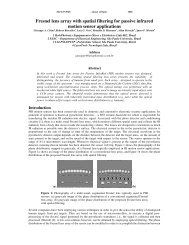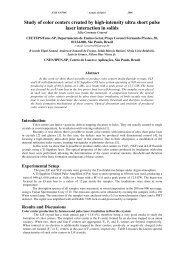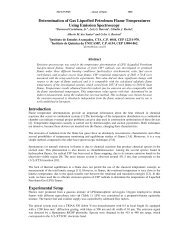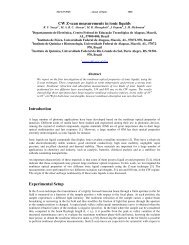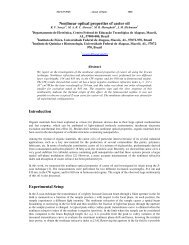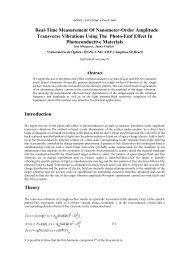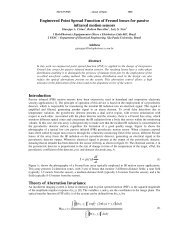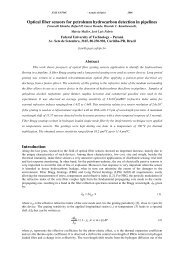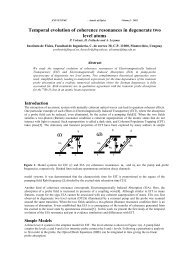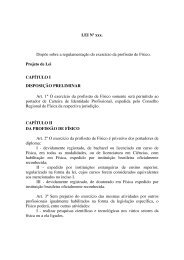Image-polarization entanglement in parametric down-conversion
Image-polarization entanglement in parametric down-conversion
Image-polarization entanglement in parametric down-conversion
You also want an ePaper? Increase the reach of your titles
YUMPU automatically turns print PDFs into web optimized ePapers that Google loves.
<strong>Image</strong>-<strong>polarization</strong> <strong>entanglement</strong> <strong>in</strong><br />
<strong>parametric</strong> <strong>down</strong>-<strong>conversion</strong><br />
D.P. Caetano and P.H. Souto Ribeiro<br />
Instituto de Física, Universidade Federal do Rio de Janeiro<br />
Caixa Postal 68528 - 21941972 Rio de Janeiro RJ Brazil<br />
phsr@if.ufrj.br<br />
J.T.C. Pardal and A.Z. Khoury<br />
Instituto de Física, Universidade Federal Flum<strong>in</strong>ense<br />
24210-340 Niterói RJ Brazil<br />
Khoury@if.uff.br<br />
Abstract<br />
We demonstrate both theoretically and experimentally the <strong>entanglement</strong> between quantum images<br />
and <strong>polarization</strong> <strong>in</strong> tw<strong>in</strong> photons generated by <strong>parametric</strong> <strong>down</strong> <strong>conversion</strong> with two crystals. This<br />
configuration has been proved to be an efficient source of E<strong>in</strong>ste<strong>in</strong>-Podolsky-Rosen (EPR) <strong>polarization</strong><br />
states. We now add the transverse degrees of freedom as a further source of <strong>entanglement</strong>. Potencial<br />
applications to quantum cryptography of images will be discussed.<br />
The <strong>in</strong>creas<strong>in</strong>g <strong>in</strong>terest on quantum <strong>in</strong>formation process<strong>in</strong>g and communication has brought the<br />
need for efficient sources of etangled states of a quantum system. In the optical doma<strong>in</strong>, the production of<br />
<strong>polarization</strong> entangled photon pairs <strong>in</strong> type II <strong>parametric</strong> <strong>down</strong>-<strong>conversion</strong> [1] has allowed many progresses<br />
<strong>in</strong> this matter. More recently, a two-crystal geometry has been employed yield<strong>in</strong>g a bright source of<br />
<strong>polarization</strong>-antangled photons [2]. This source was composed by two adjacent <strong>down</strong>-<strong>conversion</strong> (BBO)<br />
crystals cut for type-I phase match<strong>in</strong>g. The photon-pairs created by pump<strong>in</strong>g these crystals are well<br />
described by a <strong>polarization</strong>-entangled quantum state of the k<strong>in</strong>d HH + e iφ V V . The whole family of<br />
“Bell states” can be obta<strong>in</strong>ed by <strong>in</strong>troduc<strong>in</strong>g half-wave plates on signal and idler beams. As described <strong>in</strong><br />
ref. [2], the <strong>polarization</strong> <strong>entanglement</strong> is measured through <strong>polarization</strong> analysis of the <strong>down</strong>-converted<br />
photon pair. The potential applications of such a source of entangled photons are <strong>in</strong>umerous and a<br />
different aspect of this setup was exploited <strong>in</strong> ref. [3]. There, <strong>polarization</strong> <strong>entanglement</strong> was measured<br />
through position <strong>in</strong>terference. In this work, we present a multimode theory which suggests a scheme for<br />
entangl<strong>in</strong>g images to the <strong>polarization</strong> degree of freedom.<br />
The multimode quantum state generated by the two-crystal configuration can be derived tak<strong>in</strong>g<br />
<strong>in</strong>to account the angular spectrum of the pump beam. Both crystals will be considered as a box with<br />
dimensions L x , L y and L z . The crystals are labeled 1 and 2. Crystal 1 is centered at the orig<strong>in</strong> of<br />
the coord<strong>in</strong>ate system while crystal 2 is centered at d = dẑ . A pump beam provided by a colimated<br />
cont<strong>in</strong>uous monochromatic laser can be treated under the paraxial aproximation, be<strong>in</strong>g described by a<br />
multimode coherent state | v ɛp (q p )〉 where v ɛp (q p ) is the angular spectrum, q p is the transverse wave<br />
vector and ɛ p is the pump <strong>polarization</strong> vector. Furthermore, for a th<strong>in</strong> and wide crystal the phase<br />
match<strong>in</strong>g condition is very restrictive only for the transverse components of pump, signal and idler wave<br />
vectors, impos<strong>in</strong>g q s + q i = q p .<br />
Now, let us consider the experimental situation found <strong>in</strong> refs. [1] and [3]. The two crystals<br />
employed were cut for type I phase match with optical axis rotated 90 o with respect to each other. We shall<br />
suppose that the first crystal is oriented so that it is pumped by the vertical (V ) <strong>polarization</strong> component,<br />
generat<strong>in</strong>g horizontally (H) polarized signal and idler. The second crystal is therefore pumped by the<br />
horizontal (H) <strong>polarization</strong> component, generat<strong>in</strong>g vertically (V ) polarized signal and idler. The <strong>down</strong><br />
converted modes are <strong>in</strong>itially <strong>in</strong> the vacuum state so that the quantum state generated by <strong>parametric</strong><br />
<strong>in</strong>teraction up to first order is given by<br />
∫ ∫<br />
| ψ〉 = | vac〉 + C dq s dq i v V (q s + q i ) | 1 qs ,H1 qi ,H〉<br />
+ e −iφ(qs,qi,d) v H (q s + q i ) | 1 qs ,V 1 qi ,V 〉 . (1)<br />
This quantum state gives rise to quantum images impr<strong>in</strong>ted on the nonlocal two-photon correlations.<br />
<strong>Image</strong>-<strong>polarization</strong> <strong>entanglement</strong> arises from the <strong>polarization</strong> dependence of the pump angular spectrum<br />
<strong>in</strong> the quantum state above.
The co<strong>in</strong>cidence count profile on the detection planes, is given by the normally ordered correlation<br />
function<br />
C(r s , r i ) = 〈ψ | E − (r s )E − (r i )E + (r i )E + (r s ) | ψ〉 (2)<br />
where E +(−) (r) is the positive (negative) frequency part of the electric field operator on the detectors.<br />
We now take the multimode decomposition of the detected field operator<br />
∫<br />
(<br />
E + (r l ) = s<strong>in</strong> θ l dq ′ l a H (q ′ l) e i q ′ l·ρ +√ )<br />
l k 2 l −q′2 r l 1l<br />
+ cos θ l<br />
∫<br />
(<br />
dq ′ l a V (q ′ l) e i q ′ l·ρ +√ )<br />
l k 2 l −q′2 r l 2l<br />
, (3)<br />
where θ l is the angle between the vertical axis and the transmission axis of the PBS placed <strong>in</strong> front of<br />
detector l (l = s, i), ρ l is the transverse position of detector l and r jl is the distance between the center<br />
of crystal j (j = 1, 2) and the orig<strong>in</strong> of detection plane l. Moreover, a ɛ (q l ) is the anihilation operator for<br />
photons with <strong>polarization</strong> ɛ (H or V ) and transverse momentum q l . We recall that H polarized photons<br />
are created <strong>in</strong> crystal 1 while V polarized photons are created <strong>in</strong> crystal 2.<br />
Let us assume for simplicity the degenerate case k s = k i = k and k p = 2k, with a symmetric<br />
configuration such that the crystals are equidistant from signal and idler detectors: r 1i = r 1s = z and<br />
r 2i = r 2s = z ′ . Let us also assume the same orientation for the PBS <strong>in</strong> front of both detectors, so that<br />
θ s = θ i = θ A . The result<strong>in</strong>g co<strong>in</strong>dence profile is therefore<br />
C(ρ + ) = | C |2<br />
16<br />
| s<strong>in</strong> 2 θ A W V (ρ + ) + cos 2 θ A W H (ρ + )e −iϕ | 2 , (4)<br />
where ϕ = 2kd · ρ + /z , ρ + = ρ i + ρ s , and ρ l is a transverse position vector at detection plane l = s, i.<br />
This phase factor ϕ is responsible for the position <strong>in</strong>terference measured <strong>in</strong> ref.[3]. Eq.(4) shows that<br />
the spacial profile of the co<strong>in</strong>cidence counts is a mixture of the images carried by the two <strong>polarization</strong><br />
components of the pump beam. An <strong>in</strong>terest<strong>in</strong>g application arises if the two orthogonal <strong>polarization</strong>s of<br />
the pump are rotated by an angle θ P with respect to H and V . In this case the co<strong>in</strong>cidence profile for<br />
two adjacent crystals (ϕ = 0) is<br />
C(ρ + ) = | C |2<br />
| W y (ρ + ) (cos 2 θ A s<strong>in</strong> θ P + s<strong>in</strong> 2 θ A cos θ P )<br />
16<br />
+ W x (ρ + ) (cos 2 θ A cos θ P − s<strong>in</strong> 2 θ A s<strong>in</strong> θ P ) | 2 , (5)<br />
where x and y are the two orthogonal <strong>polarization</strong>s of the pump. Let us suppose that W y carries some<br />
<strong>in</strong>formation while W x carries an encod<strong>in</strong>g noisy image. From the result above one can see that for a<br />
given θ P there is always a suitable value of θ A which filters the <strong>in</strong>formation leav<strong>in</strong>g the noisy contribution<br />
out of the co<strong>in</strong>cidence profile. This suggests a scheme for criptographic communication where the sender<br />
mixes the two images up and sends the tw<strong>in</strong> beams to a receiver who makes the <strong>polarization</strong> analysis.<br />
HeCd Laser<br />
BS<br />
<strong>Image</strong> 2<br />
M<br />
<strong>Image</strong> 1<br />
λ/2<br />
M<br />
M<br />
λ/2<br />
LiIO 3<br />
PBS<br />
λ/2<br />
PBS<br />
λ/2<br />
( θ P<br />
)<br />
D 1<br />
D 2<br />
θ A<br />
VM<br />
BS<br />
M<br />
C<br />
θ A<br />
Figure 1: Experimental setup.
¤¦<br />
¡¦<br />
©<br />
¦<br />
¨¦<br />
<br />
! " # $ % &' && &(<br />
'<br />
Due to the phase match<strong>in</strong>g conditions of our crystals (two LiIO 3 crystals cut for type I phase<br />
match) it was not possible to employ the two crystals <strong>in</strong> sequence as <strong>in</strong> refs.[2] and [3]. We therefore<br />
built the experimental setup sketched <strong>in</strong> Fig.1. The pump beam is divided <strong>in</strong> a 50%/50% nonpolariz<strong>in</strong>g<br />
beam splitter (BS) and an image is formed on each output. The <strong>polarization</strong> of the beam carry<strong>in</strong>g image<br />
2 is rotated at 90 o by a halfwave plate (HWP) and the two images are recomb<strong>in</strong>ed on a polariz<strong>in</strong>g beam<br />
splitter. Therefore, the pump beam carries two images on orthogonal <strong>polarization</strong>s, a horizontal (H) and<br />
a vertical one (V ). The vertical image is a collimated Gaussian and the horizontal image is a displaced<br />
focussed Gaussian (Fig.2). We shall use the language suggested by our application proposal and call the<br />
two images carried by the pump beam as noise and <strong>in</strong>formation, respectively.<br />
¦ ¥<br />
(a)<br />
<br />
¥§¦<br />
©<br />
©©<br />
¡ ¢ £ ¤ ¥¦ ¥¥ ¥§<br />
&('<br />
(b)<br />
%'<br />
*+0-123<br />
"'<br />
4 2 )'<br />
*+,-*,./-*/<br />
5676879:;9?@@A<br />
Figure 2: (a) Vertical image transfered to both crystals(noise); (b) Horizontal image transfered to both<br />
crystals(<strong>in</strong>formation). θ A = 45 o . Solid l<strong>in</strong>es correspond to gaussian fit.<br />
At the output of the first polariz<strong>in</strong>g beam splitter (PBS), we placed a second HWP to produce a<br />
pair of orthogonal <strong>polarization</strong>s rotated by θ P with respect to H and V . The second PBS, then, projects<br />
images 1 and 2 along H and V , and distributes them between the two crystals. Instead of employ<strong>in</strong>g<br />
two crystals with orthogonal optical axis, we oriented the optical axis of the two crystals parallel to each<br />
other and <strong>in</strong>troduced a HWP before one of them. In order to achieve <strong>polarization</strong> <strong>entanglement</strong> another<br />
HWP was <strong>in</strong>troduced after the other crystal. Therefore, the quantum state generated by the setup is<br />
∫ ∫<br />
| ψ〉 = | vac〉 + C dq s dq i v H (q s + q i ) | 1 qs ,H1 qi ,H〉<br />
+ e −iφ(q s,q i ,d) v V (q s + q i ) | 1 qs ,V 1 qi ,V 〉 . (6)<br />
Notice that this state is slightly different from the one given by Eq.1. However, this difference is not<br />
essential s<strong>in</strong>ce the <strong>entanglement</strong> between <strong>polarization</strong> and transverse momentum degrees of freedom is<br />
still present.<br />
F<strong>in</strong>ally, the H polarized and the V polarized tw<strong>in</strong> photons are mixed at a 50%/50% nonpolariz<strong>in</strong>g<br />
beam splitter (BS). Each output of this BS is filtered <strong>in</strong> order to block the transmitted pump beam<br />
and sent to a photocounter for co<strong>in</strong>cidence detection. A polarizer is placed before each photocounter,<br />
both oriented at an angle θ A with respect to V . A straightforward calculation on the same l<strong>in</strong>es of the<br />
one lead<strong>in</strong>g to Eq.(15) gives the co<strong>in</strong>cidence profile as<br />
C(ρ + ) = | C |2<br />
| W y (s<strong>in</strong> 2 θ A s<strong>in</strong> θ P + cos 2 θ A cos θ P )<br />
16<br />
+ W x (s<strong>in</strong> 2 θ A cos θ P − cos 2 θ A s<strong>in</strong> θ P ) | 2 , (7)<br />
where W x (ρ) and W y (ρ) are the two images carried by the pump beam, with <strong>polarization</strong>s x and y rotated<br />
by θ P with respect to H and V . As before, for a given orientation of the pump (θ P ), there is a orientation<br />
of the analizers (θ A ) which filters the noise and provides the cleanned <strong>in</strong>formation.
*+,-*,<br />
©©<br />
! " # $ % &' && &(<br />
'<br />
This pr<strong>in</strong>ciple is experimentally demonstrated <strong>in</strong> Fig.3, where θ P is fixed at −30 o while the<br />
analizers are varied to provide the noiseless <strong>in</strong>formation. In Fig.3(a) the analizers are oriented at 45 o<br />
giv<strong>in</strong>g a noisy <strong>in</strong>formation while <strong>in</strong> Fig.3(b) the niseless <strong>in</strong>formation is recovered when the analizers are<br />
set to θ A = 37 o .<br />
¥§¦<br />
(a)<br />
¤¦ <br />
¡¦<br />
©© ¨¦<br />
¦<br />
¡ ¢ £ ¤ ¥¦ ¥¥ ¥§<br />
<br />
(''<br />
(b)<br />
&"'<br />
&('<br />
$'<br />
. /-*/*+0-12342 )'<br />
<br />
Figure 3: (a) Information <strong>in</strong> the presence of noise. θ P = −30 o and θ A = 45 o ; (b) Recovered <strong>in</strong>formation.<br />
θ P = −30 o and θ A = 37 o . Solid l<strong>in</strong>es correspond to gaussian fit.<br />
In summary, we applied a multimode theory for <strong>parametric</strong> <strong>down</strong> <strong>conversion</strong> with two crystals.<br />
Besides the usual <strong>polarization</strong> <strong>entanglement</strong>, this setup is shown to be a device for image-<strong>polarization</strong><br />
<strong>entanglement</strong> and potential applications on quantum communication can be envisaged. Our experimental<br />
results are <strong>in</strong> very good agreement with the theory developed.<br />
The authors aknowledge f<strong>in</strong>ancial support from the Brazilian agencies Conselho Nacional de<br />
Desenvolvimento Científico e Tecnológico (CNPq), Coordenação de Aperfeiçoamento de Pessoal de Nível<br />
Superior (CAPES) and Fundação de Amparo à Pesquisa do Estado do Rio de Janeiro (FAPERJ).<br />
References<br />
[1] P. Kwiat et al.; Phys. Rev. Lett. 75, 4337 (1995).<br />
[2] P. Kwiat et al.; Phys. Rev. A 60, R773 (1999).<br />
A.G. White et al.; Phys. Rev. Lett. 83, 3103 (1999).<br />
[3] M. França Santos et al.; Phys. Rev. A 64, manuscr.# 023804 (2001).



